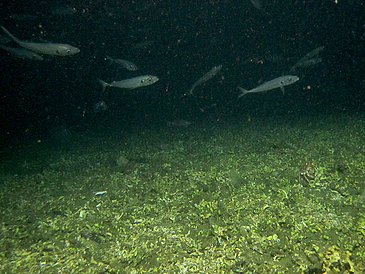As so-called ecosystem engineers, cold-water corals play an important role in terms of species diversity in the deep sea. The coral type Lophelia pertusa is a key contributor to reef development. Its branched, hard chalk skeleton offers protection, breeding, and living space for a number of other animal species. Over thousands of years, these corals form mound-like reef structures on the seabed. The structures can reach heights of over 100 meters and lengths of several thousand meters.
Cold-Water Corals Lived 9,500 to 4,500 Years Ago
In 2016, over 2,000 cold-water coral mounds were found off the coast of Namibia at water depths between 160 and 270 meters during an expedition with the METEOR research vessel. The mounds extend over 80 kilometers along the shelf and thus form the largest coral mound province discovered to date in the southeast Atlantic. However, underwater recordings show that the cold-water corals have been dead for a while. In order to find out exactly when the corals died and which environmental factors caused their death, a research team took sediment samples from various coral mounds during the METEOR M122 expedition. From said samples, stony skeletal-pieces of Lophelia pertusa were then removed. The dating of the samples has shown that the cold-water corals lived off the shore of Namibia 9,500 to 4,500 years ago – thus from the early to the mid-Holocene – and formed mounds with a height of up to 20 meters.
As the cold-water corals fuse their skeletons with the seabed, they are dependent on currents transporting nutritional particles to them. Additionally, they react very sensitively to changing environmental factors. Alongside the supply of food, these factors include the temperature and pH value of the water and the oxygen level. If one or more factors change, the corals become stressed, which can eventually lead to their localized death. The fact that no new corals have formed on the remains of the old coral in the last 4,500 years points to an ecological environment that has prevented such coral growth since then. The team of authors is convinced that the low concentration of oxygen of less than half of a milliliter of oxygen per liter of water has impeded the coral growth off the shore of Namibia to date. “These values are far lower than all oxygen concentrations measured around Lophelia pertusa in the Atlantic to date,” says Leonardo Tamborrino from MARUM – Center for Marine Environmental Sciences at the University of Bremen.
Oxygen Levels in Water Too Low
The shelf off the coast of Namibia is controlled by the Benguela upwelling system, which causes cold, nutrient-rich water to flow upwards from the depths. This results in Namibia’s coast being one of the most productive areas of the world seas, which initially appears to be positive factor in coral growth. However, the subsequent decomposition of the organic matter uses a great deal of oxygen. This leads to the waters near to the coast containing only a small amount of oxygen. In the mid-Holocene, the Benguela upwelling system strengthened. At the same time, a related frontal system, the Angola-Benguela front, moved towards the equator. Leonardo Tamborrino and his colleagues reason that both processes have caused an intensification of the oxygen minimum zone off the coast of Namibia and have therefore triggered the death of the coral there.
Further Information:
METEOR M122 expedition logbook: https://www.marum.de/Entdecken/Logbuch-METEOR-122.html (in German only)
Information on coral mounds: https://www.marum.de/en/Discover/Coral-mound.html
Contact:
Leonardo Tamborrino
Marine Sedimentology
Phone: +49 421 218-65678
Email: ltamborrinoprotect me ?!marumprotect me ?!.de
Original publication:
Leonardo Tamborrino, Claudia Wienberg, Jürgen Titschack, Paul Wintersteller, Furu Mienis, Andrea Schröder-Ritzrau, André Freiwald, Covadonga Orejas, Wolf-Christian Dullo, Julia Haberkern und Dierk Hebbeln: Mid-Holocene extinction of cold-water corals on the Namibian shelf steered by the Benguela oxygen minimum zone. Geology 2019.
DOI:10.1130/G46672.1

